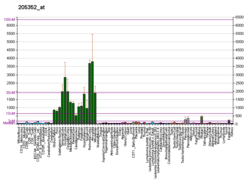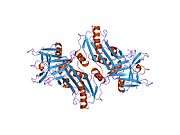SERPINI1
Neuroserpin is a protein that in humans is encoded by the SERPINI1 gene.[4]
It is associated with Familial encephalopathy with neuroserpin inclusion bodies.
Serine protease inhibitors of the serpin superfamily are involved in many cellular processes. Neuroserpin was first identified as a protein secreted from the axons of dorsal root ganglion neurons (Stoeckli et al., 1989). It is expressed in the late stages of neurogenesis during the process of synapse formation.[supplied by OMIM][4]
Interactions
SERPINI1 has been shown to interact with Tissue plasminogen activator.[5]
gollark: Or which is better. Arch is obviously better always
gollark: ë
gollark: Arch sub reddit?
gollark: There is always a point in running Arch.
gollark: <@175686996461617162> nope.
References
- GRCh38: Ensembl release 89: ENSG00000163536 - Ensembl, May 2017
- "Human PubMed Reference:". National Center for Biotechnology Information, U.S. National Library of Medicine.
- "Mouse PubMed Reference:". National Center for Biotechnology Information, U.S. National Library of Medicine.
- "Entrez Gene: SERPINI1 serpin peptidase inhibitor, clade I (neuroserpin), member 1".
- Parmar, Parmjeet K; Coates Leigh C; Pearson John F; Hill Rena M; Birch Nigel P (September 2002). "Neuroserpin regulates neurite outgrowth in nerve growth factor-treated PC12 cells". J. Neurochem. 82 (6): 1406–15. doi:10.1046/j.1471-4159.2002.01100.x. ISSN 0022-3042. PMID 12354288.
Further reading
- Yepes M; Lawrence DA (2004). "Neuroserpin: a selective inhibitor of tissue-type plasminogen activator in the central nervous system". Thromb. Haemost. 91 (3): 457–64. doi:10.1160/TH03-12-0766. PMID 14983220.
- Schrimpf SP, Bleiker AJ, Brecevic L, et al. (1997). "Human neuroserpin (PI12): cDNA cloning and chromosomal localization to 3q26". Genomics. 40 (1): 55–62. doi:10.1006/geno.1996.4514. PMID 9070919.
- Hastings GA, Coleman TA, Haudenschild CC, et al. (1998). "Neuroserpin, a brain-associated inhibitor of tissue plasminogen activator is localized primarily in neurons. Implications for the regulation of motor learning and neuronal survival". J. Biol. Chem. 272 (52): 33062–7. doi:10.1074/jbc.272.52.33062. PMID 9407089.
- Davis RL, Shrimpton AE, Holohan PD, et al. (1999). "Familial dementia caused by polymerization of mutant neuroserpin". Nature. 401 (6751): 376–9. doi:10.1038/43894. PMID 10517635.
- Chang WS, Chang NT, Lin SC, et al. (2000). "Tissue-specific cancer-related serpin gene cluster at human chromosome band 3q26". Genes Chromosomes Cancer. 29 (3): 240–55. doi:10.1002/1098-2264(2000)9999:9999<::AID-GCC1029>3.0.CO;2-A. PMID 10992299.
- Belorgey D; Crowther DC; Mahadeva R; Lomas DA (2002). "Mutant Neuroserpin (S49P) that causes familial encephalopathy with neuroserpin inclusion bodies is a poor proteinase inhibitor and readily forms polymers in vitro". J. Biol. Chem. 277 (19): 17367–73. doi:10.1074/jbc.M200680200. PMID 11880376.
- Davis RL, Shrimpton AE, Carrell RW, et al. (2002). "Association between conformational mutations in neuroserpin and onset and severity of dementia". Lancet. 359 (9325): 2242–7. doi:10.1016/S0140-6736(02)09293-0. PMID 12103288.
- Barker-Carlson K; Lawrence DA; Schwartz BS (2003). "Acyl-enzyme complexes between tissue-type plasminogen activator and neuroserpin are short-lived in vitro". J. Biol. Chem. 277 (49): 46852–7. doi:10.1074/jbc.M207740200. PMID 12228252.
- Parmar PK, Coates LC, Pearson JF, et al. (2002). "Neuroserpin regulates neurite outgrowth in nerve growth factor-treated PC12 cells". J. Neurochem. 82 (6): 1406–15. doi:10.1046/j.1471-4159.2002.01100.x. PMID 12354288.
- Strausberg RL, Feingold EA, Grouse LH, et al. (2003). "Generation and initial analysis of more than 15,000 full-length human and mouse cDNA sequences". Proc. Natl. Acad. Sci. U.S.A. 99 (26): 16899–903. Bibcode:2002PNAS...9916899M. doi:10.1073/pnas.242603899. PMC 139241. PMID 12477932.
- Miranda E; Römisch K; Lomas DA (2004). "Mutants of neuroserpin that cause dementia accumulate as polymers within the endoplasmic reticulum". J. Biol. Chem. 279 (27): 28283–91. doi:10.1074/jbc.M313166200. PMID 15090543.
- Teesalu T, Kulla A, Simisker A, et al. (2005). "Tissue plasminogen activator and neuroserpin are widely expressed in the human central nervous system". Thromb. Haemost. 92 (2): 358–68. doi:10.1160/TH02-12-0310. PMID 15269833.
- Belorgey D, Sharp LK, Crowther DC, et al. (2004). "Neuroserpin Portland (Ser52Arg) is trapped as an inactive intermediate that rapidly forms polymers: implications for the epilepsy seen in the dementia FENIB". Eur. J. Biochem. 271 (16): 3360–7. doi:10.1111/j.1432-1033.2004.04270.x. PMID 15291813.
- Gerhard DS, Wagner L, Feingold EA, et al. (2004). "The status, quality, and expansion of the NIH full-length cDNA project: the Mammalian Gene Collection (MGC)". Genome Res. 14 (10B): 2121–7. doi:10.1101/gr.2596504. PMC 528928. PMID 15489334.
- Onda M; Belorgey D; Sharp LK; Lomas DA (2005). "Latent S49P neuroserpin forms polymers in the dementia familial encephalopathy with neuroserpin inclusion bodies". J. Biol. Chem. 280 (14): 13735–41. doi:10.1074/jbc.M413282200. PMID 15664988.
- Rual JF, Venkatesan K, Hao T, et al. (2005). "Towards a proteome-scale map of the human protein-protein interaction network". Nature. 437 (7062): 1173–8. Bibcode:2005Natur.437.1173R. doi:10.1038/nature04209. PMID 16189514.
- Kinghorn KJ, Crowther DC, Sharp LK, et al. (2006). "Neuroserpin binds Abeta and is a neuroprotective component of amyloid plaques in Alzheimer disease". J. Biol. Chem. 281 (39): 29268–77. doi:10.1074/jbc.M600690200. PMID 16849336.
- Chen PY, Chang WS, Chou RH, et al. (2007). "Two non-homologous brain diseases-related genes, SERPINI1 and PDCD10, are tightly linked by an asymmetric bidirectional promoter in an evolutionarily conserved manner". BMC Mol. Biol. 8: 2. doi:10.1186/1471-2199-8-2. PMC 1796892. PMID 17212813.
- Gourfinkel-An I, Duyckaerts C, Camuzat A, et al. (2007). "Clinical and neuropathologic study of a French family with a mutation in the neuroserpin gene". Neurology. 69 (1): 79–83. doi:10.1212/01.wnl.0000265052.99144.b5. PMID 17606885.
This article is issued from Wikipedia. The text is licensed under Creative Commons - Attribution - Sharealike. Additional terms may apply for the media files.




